CRJ 14:2 - out now, here's what's in the latest issue
This edition of CRJ covers a wide variety of themes, ranging from the overarching future threats that face the planet, down to the level of personal resilience and individual citizen responsibility in preparedness and response, and how governments can trust – and enable – their citizens to help themselves in times of crisis. We also look at the drone incident at Gatwick Airport from a risk management perspective, as well as more analysis on communications, social media and trust – an ever evolving subject.Emily Hough interviews Dr Daniel Kaniewski of FEMA, Elton Cesar Cunha of Civil Defence in Barra Velha, Brazil and, for our Frontline feature, finds more about an all-female anti-poaching unit in South Africa.
On the safety and security front, we examine kidnap and ransom, the myth of the so-called ‘lone wolf’ and how specialist insurance and training can protect staff when travelling overseas.
Our write-up on the European Forum for Disaster Risk Reduction (EDFRR) comes courtesy of four of the experts who were instrumental during this seminal event in November 2018. As Paola Albrito explains, the event shows that: “The link between disaster risk reduction, societal resilience and economic prosperity has never been clearer.”
Plus, news, security, Sweden’s wildfires of 2018, a look at how some third sector operators appear to have lost connection to their original mission, and the article by Wilfred Kreuger about how he and his team dealt with the immediate aftermath of the shooting down of Malaysian Airlines MH17.
CRJ is available in hard copy and online to subscribers only – click here for more details.
Comment
Joining the dots: Are we gambling with crisis?
In this first edition of 2019 it is appropriate to take a look at the overall disaster picture and the need for all sectors of society to work together, rather than fragmenting under pressure, writes Emily Hough, in Part I of a two-part comment series
Analysis
Sweden’s wildfires of 2018
Ulrika Lindmark, overall incident leader during the Kårböle wildfire operation in Sweden last year, discusses leadership and international collaboration during one of the country’s largest wildfires in history
Gatwick drone incident
The recent Gatwick drone shutdown provides an outstanding example of the difference between security management and risk management, according to David Rubens
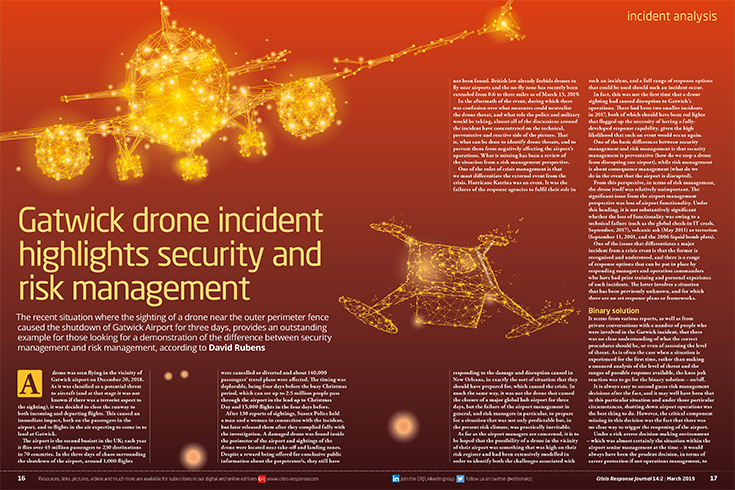
Meeting the drone security challenge
Security professionals are regularly asked if they are prepared to counter the threat posed by small drones. In this article Christopher Korody reviews the threat, looks at some of the available technology and suggests ways that you can start planning your response today
Social licence, crisis resilience and social media
A brand’s social licence is a critical component to its survival today. Rooted in a foundation of trust and transparency, the continuous approval and acceptance of a company and its operations by the community is crucial, albeit complex, contends Emmanuelle Hervé
Deciding will be decisive
Procedures and manuals will always play an indispensable role in orchestrating an effective response, but they might have reached their limitations, because today’s crisis communication stands on the edge of tomorrow, says Patrick Meschenmoser
Cargo cults and the third sector
This commentary, written by a highly experienced search and rescue operative, voices concerns about a minority of third sector organisations across the world that have lost connection to their original purpose and exist now purely as a form of social club, or a self-perpetuating social media phenomenon
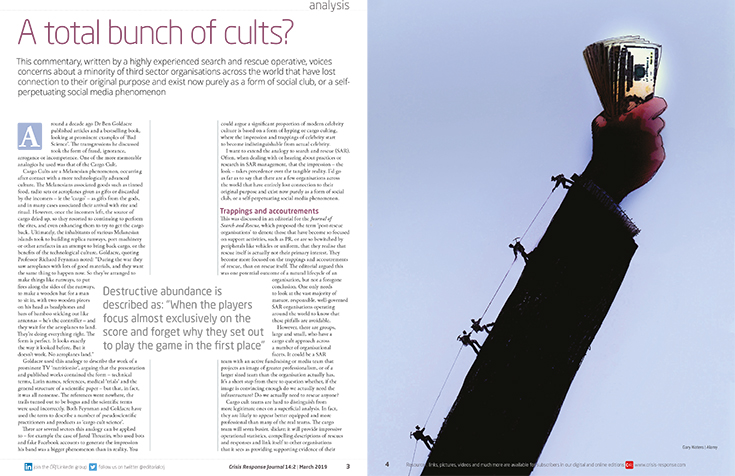
The challenges of a Brazilian civil defence agent
Emily Hough speaks to Elton Cesar Cunha, Municipal Director of Protection and Civil Defence of Barra Velha, about his work in this small city on the Brazilian coast, a city that has its fair share of risks and hazards
Citizens & resilience
Citizen behaviour and crises
Dr Daniel Kaniewski, Deputy FEMA Administrator for Resilience, tells Emily Hough about how this federal agency is working to make American society more resilient – and the vital role that insurance has to play
Resilient cities and states
Dennis Davis contends that now is the time for an alternative view on the citizen-state relationship; a paradigm shift where individual citizens interact with authorities and first responders in resource and reporter roles rather than being viewed as receptors and requesters
Preparing the public
Sweden wants its population to be able to handle a situation where important social functions do not work or are subject to massive disruption, no matter what the cause, says Christina Andersson
MH17 the station manager’s story
Wilfred Kreuger recounts the day he experienced every airline station manager’s nightmare – a call telling him that something had happened to Malaysia Airlines Flight MH17, which he had seen off at Schiphol Airport. This is his story
The heart of resilience
Eldred Willey calls for a positive attitude to recruiting or partnering with local people who have experienced trauma, as they can bring core resilience in the field
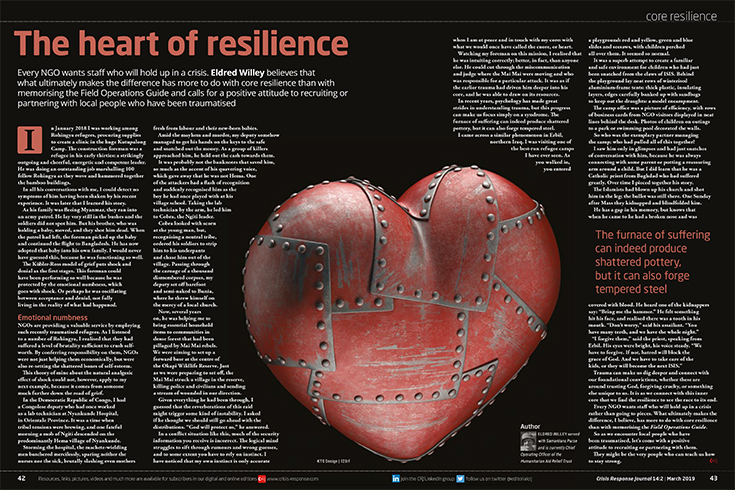
Making sense of working with terror victims
Nicola Lester introduces a trauma informed model of practice to work with the victims of terrorist attacks, particularly in the immediate aftermath of an incident
Women in the global war on counterfeiting
This interview with two women on the frontline in the global war on counterfeiting, finds out how they work and the dangers of fake goods, as well as the far reaching effects of such criminal activities
Leadership
Servant leadership for first responders
Eric Russell provides some thoughts on the characteristics of first responders, and what sort of leadership they deserve to help them in their jobs, not least when navigating internal bureaucracies

The future of humanitarian learning
As innovative learning solutions begin to show great potential, the next challenge lies in ensuring local humanitarians and organisations can access and adapt these tools to their specific needs in difficult contexts, say Atish Gonsalves and Anne Garçon
Resilient leadership in crisis response
Drawing upon her experience in the field, Alice Bromage looks at the four elements of resilient leadership: Clarity of direction; resilient decision-making; awareness; and leadership presence
Safety & security
The myth of the lone wolf terrorist
Casey Brunelle says that the term ‘lone wolf’ in a terrorist context is unhelpful for counter terrorism research, because the overwhelming majority of terrorists – including lone actors – simply do not act in an asocial vacuum
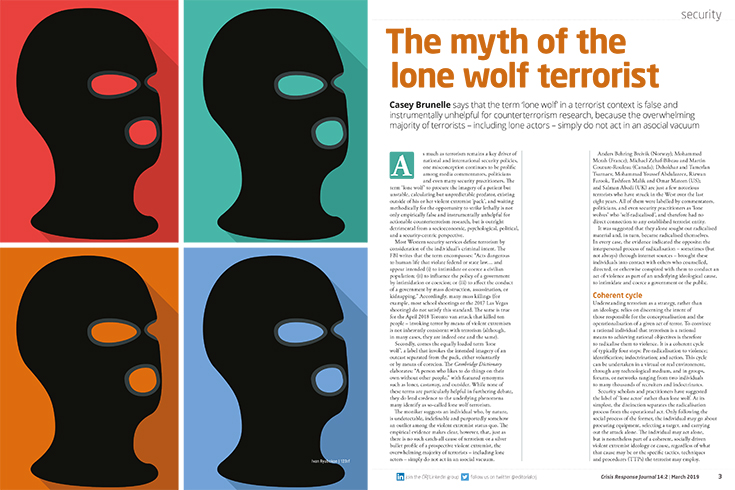
Call for consistency in kidnap response
Lina Kolesnikova explores the crimes of kidnapping and ransom, calling for standardisation of response to ransom demands, more training for negotiators and improved programmes for victims and their families
Building a corporate security sandbox
How can corporate security officers identify and gauge the magnitude of events that could put a company’s employees and assets in jeopardy? Tim Willis has some pointers to address this daunting task
Be prepared: Crisis solutions
The threat of a serious crisis is no longer confined to economic or politically unstable countries across the globe, says Giles Greenfield and employers sending their staff overseas for business have a duty of care
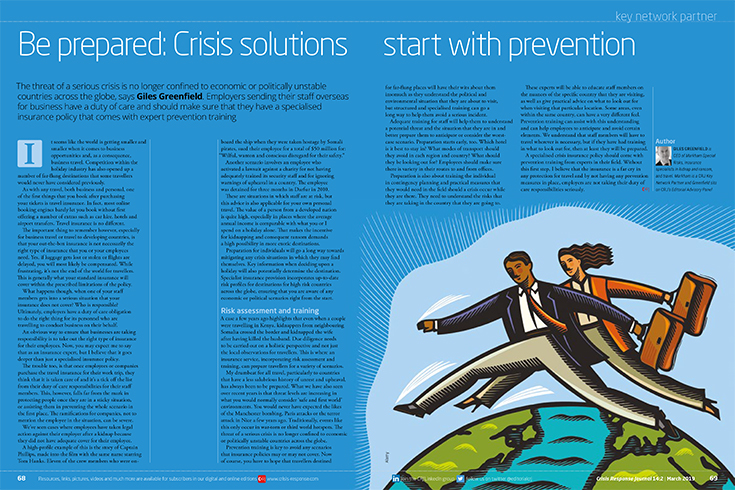
Global risks
The backbones of disaster resilience
Paola Albrito gives an overview of the European Forum for Disaster Risk Reduction event, which was held in Rome in November 2018, saying that the link between disaster risk reduction, societal resilience and economic prosperity has never been clearer
Black swans and grey rhinos
Korbinian Breinl examines why we still fail to respond to obvious but neglected major threats – grey rhinos – and still focus too much on identifying black swans, which are, by definition, not predictable
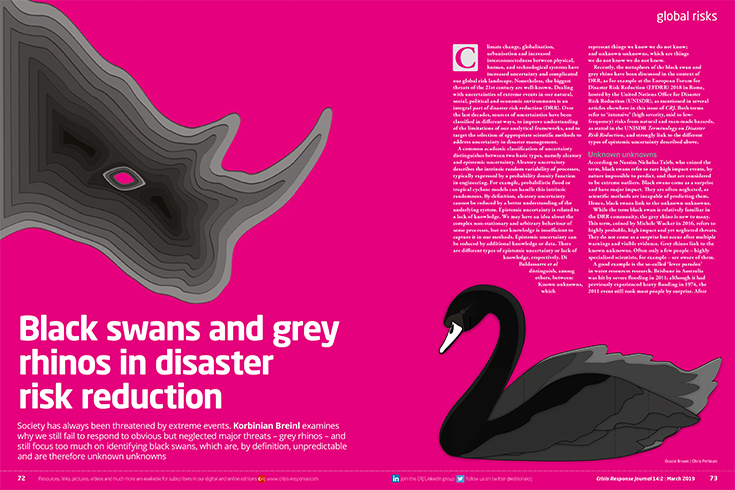
Preparing for new risk scenarios
In November 2018, Emily Hough chaired the session on Emerging Risks at the EDFRR in Rome, Italy. Paolo Garonna was one of the distinguished panellists who took part. Here are his thoughts
Small-scale producers on the frontlines
Dominique Burgeon expands upon his comments at the EUFDRR on the need for disaster risk reduction in the agricultural sector to safeguard livelihoods and address rising hunger
Humanitarian & Third Sector
Expanding the boundaries of healthcare
When hospitals and medical facilities are struck by disasters staff, patients and wider societal resilience all suffer, writes Steve Peak. This is where mobile healthcare facilities come into their own – especially during the recovery phase
The Internet as a tool for civil protection
Research by Jurisic Dragisa has discovered worrying gaps in information provided online by many administrations in Bosnia Herzegovina
Humanitarian supply chains
Charlie Reeves says that strong supply chain management is now understood to be a key driver of performance for humanitarian organisations, so their supply chains have become ever more effective and resilient
Reducing risk in the Asia-Pacific
The Asia-Pacific is the most disaster-prone area of the world. Floods, cyclones, earthquakes, and sand and dust storms lead to loss of life, and trap people in poverty over generations, while economic costs are on the rise, writes Mostafa Mohaghegh
Nepal’s new disaster law
Albrecht Beck and Josef Riener describe how new legislation that covers the whole spectrum of emergency preparedness, hazard mitigation and disaster risk management, is being implemented and validated in Nepal
Consistency in an unpredictable world
Stuart Smith says that Volga-Dnepr’s new cargo supermarket is that it creates unique combined solutions, especially for the aid sector when responding to large, global disasters or humanitarian incidents
The future of public warning
How much of the technology that we use today is the same as back in World War Two? It’s a struggle to think of many, when the ways we travel, work and spend our free time have all changed so dramatically. It’s even more difficult if we think about the public safety world, says Rose Michael
Protecting wildlife from poachers
Emily Hough catches up with Alice Bromage, to speak about her work with the first majority female anti-poaching unit, based in Balule Reserve, the Greater Kruger Area, in South Africa, helping to protect the reserve’s endangered species
For more details on how to subscribe, click here. To learn about our Key Network Partnerships, click here